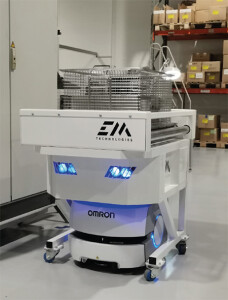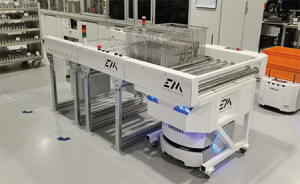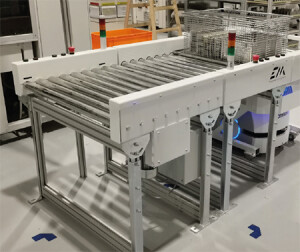Fast and safe transport on the factory floor
 Three autonomous mobile robots (AMRs) have been helping Philips Austria with the internal transport of materials for the past two years. To increase the acceptance of these new robot colleagues, the employees at the plant gave them names: Jaqueline, Chiara and Sepp. The LD mobile robots from Omron are used in combination with solutions from an Omron partner, EM Technologies.
Three autonomous mobile robots (AMRs) have been helping Philips Austria with the internal transport of materials for the past two years. To increase the acceptance of these new robot colleagues, the employees at the plant gave them names: Jaqueline, Chiara and Sepp. The LD mobile robots from Omron are used in combination with solutions from an Omron partner, EM Technologies.
The migration from manual transport processes to mobile robots is part of a broad modernisation project at Philips. In its move towards Factory 4.0, the group relies step by step on lean mechanisation; digitisation tools in production and the office; predictive maintenance and quality; and automated workflows. The primary goal of all of these individual projects is ‘smart manufacturing’.
Founded in 1881 in the Netherlands, Philips employs more than 73,000 people worldwide, some 300 of whom work in Klagenfurt, Austria. This is the location of one of five worldwide Philips competence centres for personal care. The Philips site in Klagenfurt produces, among other items, over 23 million linear cutting elements for hair and beard trimmers each year. These beard trimmers have lift-and-trim technology: the beard hair is first lifted with the help of special trimming attachments and then evenly cut off by the double-acting stainless steel blades.
The transportation of these cutting elements in the Klagenfurt plant was carried out for many years by machine operators. This was a time-consuming and inefficient process that needed to be automated in order to relieve the burden on employees and optimise Overall Equipment Effectiveness (OEE). This would free employees so that they would have more time to use their skills on other, more creative and demanding tasks.
The Future Factory programme at Philips started in 2017. “Back then, we wanted to show our colours very quickly and initiate the first smart manufacturing projects. The AMRs fit well here because they can be implemented quickly,” reports Siegfried Seufzer, operations manager for production of personal care products at Philips Klagenfurt.
When choosing the right robots, the project team compared different providers, but quickly decided on Omron. “The dimensions of the robot had to be small, and that’s where their devices fit best. We wanted a system without tracks because it takes up less space. In addition, the AMR can easily be linked to SAP, which was another of our requirements. The interfaces were all there. We also already knew Omron. We were able to build on that,” Seufzer comments.
Further advantages in favour of the Omon robots included their ease of use, the relatively high transport speeds, and their functional reliability in confined areas. If an AMR ever comes across an employee who is in its way, the robot can warn them. This never involves loud beeps or a warning tone. The Omron devices have voice functions; their voices are similar to those in a navigation system.
 AMRs can transport up to 70 kilos per trip
AMRs can transport up to 70 kilos per trip
The material transport by the employees previously took about 15 minutes a day: “Valuable time that can be used far more sensibly,” says Seufzer. In this context, calculations have shown that the use of an AMR can increase the OEE by 3%.
The safety of the robots is another aspect that was considered. In an emergency, for example, the Omron AMR can drive to a place where it is out of the way of any emergency teams. Today the robots transport 500 to 1,000 cutting elements per carrier. Each AMR can carry up to ten containers; there are 10,000 elements with a total weight of 60 to 70 kg. The robot colleagues, Jaqueline, Chiara and Sepp, drive every half hour. A single round trip covers about 400m. In the future, the aim is to transport significantly heavier materials with mobile robots to further relieve the burden on employees.
There are other positive effects that the project team hadn’t even considered beforehand. For instance, the quality of the transported parts has improved. The flow of material was previously disjointed, and this led to product damage on the tightly packed transport trolleys. Now that the flow of material is continuous, more journeys are made, but the items are handled more gently. Transport damage is a thing of the past. There are always two robots on the move while the third unit is being charged.
Communication takes place not only between the machine and the AMR but also between the AMR and the employee. For safety reasons, departures are announced in advance and the employee is informed about the prevailing situation. Any obstacles can be recognised by the robots at lightning speed and can be avoided by using alternative routes. The coordination of several AMRs, including charging management, is also done autonomously.
The factory of the future
The migration from manual transport to automated processes, supported by AMRs, is a good entry point for many companies that are moving towards Factory 4.0 – including Philips. This is partly because their introduction can take place in an easily understandable and tangible way. “An MES system is nice and has great graphics and more. However, an AMR is much easier to personalise – that‘s why our devices also have names,” says production manager, Sigh. An Omron LD mobile robot can be into the production environment within three hours.
In addition to the 3% improvement in the OEE values of the assembly lines due to automated supply, the Philips project team has noticed other positive effects. The company saves up to 500 containers, due to the continuous material transport. If the work-in-progress (WIP) previously took several days, it could be reduced to a few hours by automated continuous material supply.
“This is an enormous advantage that is difficult to assess financially, but it is still a great improvement. It no longer collects dust, and a reliable overview is guaranteed at all times if, for example, quality defects should occur,” explains Seufzer. The AMRs immediately send back items that don’t meet the specifications.
Outlook: mobile robots should get smarter and smarter
In the next step, an AMR will be actively integrated into the production process in cooperation with Omron’s partners. In addition to transport functions, the mobile robot can also take on the independent activation of systems; the completion of process steps; and the booking of orders via QR codes. Fully automatic booking in the SAP system is also planned. The AMR can communicate independently with the machine.
 The AMRs are currently operating the cleaning machine at the Philips plant in Klagenfurt, which removes dirt and grinding dust from the cutting elements. In the future, a combination of the MES system and AMRs is also planned. This means, for example, that if the supply of a material is running low, this can be communicated in advance – so the material supply is controlled by the systems.
The AMRs are currently operating the cleaning machine at the Philips plant in Klagenfurt, which removes dirt and grinding dust from the cutting elements. In the future, a combination of the MES system and AMRs is also planned. This means, for example, that if the supply of a material is running low, this can be communicated in advance – so the material supply is controlled by the systems.
Jürgen Holzapfel-Epstein, business development manager for robotics at Omron Industrial Automation, concludes: “The use of autonomous mobile robots at Philips Austria is a prime example of how digitisation and automation can be advanced step by step, but still holistically, in the factory of the future. The cooperation between Philips, Omron and EM Technologies was easy and we can always see eye to eye, which is of great importance for the success of such a project.”
Visit the Omron website for more information















